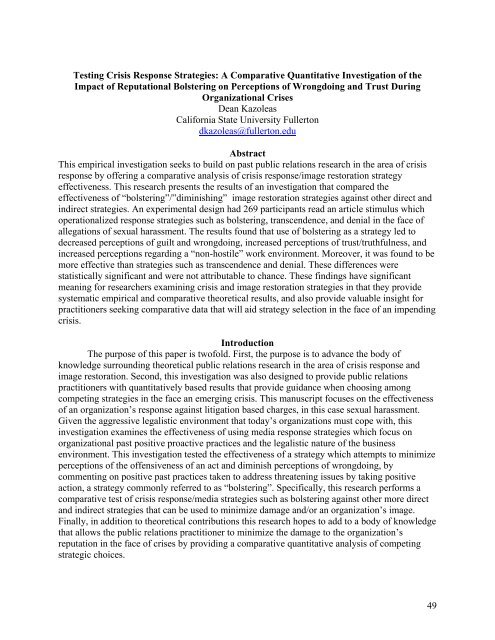2008 PROCEEDINGS - Public Relations Society of America
2008 PROCEEDINGS - Public Relations Society of America
2008 PROCEEDINGS - Public Relations Society of America
Create successful ePaper yourself
Turn your PDF publications into a flip-book with our unique Google optimized e-Paper software.
Testing Crisis Response Strategies: A Comparative Quantitative Investigation <strong>of</strong> the<br />
Impact <strong>of</strong> Reputational Bolstering on Perceptions <strong>of</strong> Wrongdoing and Trust During<br />
Organizational Crises<br />
Dean Kazoleas<br />
California State University Fullerton<br />
dkazoleas@fullerton.edu<br />
Abstract<br />
This empirical investigation seeks to build on past public relations research in the area <strong>of</strong> crisis<br />
response by <strong>of</strong>fering a comparative analysis <strong>of</strong> crisis response/image restoration strategy<br />
effectiveness. This research presents the results <strong>of</strong> an investigation that compared the<br />
effectiveness <strong>of</strong> “bolstering”/”diminishing” image restoration strategies against other direct and<br />
indirect strategies. An experimental design had 269 participants read an article stimulus which<br />
operationalized response strategies such as bolstering, transcendence, and denial in the face <strong>of</strong><br />
allegations <strong>of</strong> sexual harassment. The results found that use <strong>of</strong> bolstering as a strategy led to<br />
decreased perceptions <strong>of</strong> guilt and wrongdoing, increased perceptions <strong>of</strong> trust/truthfulness, and<br />
increased perceptions regarding a “non-hostile” work environment. Moreover, it was found to be<br />
more effective than strategies such as transcendence and denial. These differences were<br />
statistically significant and were not attributable to chance. These findings have significant<br />
meaning for researchers examining crisis and image restoration strategies in that they provide<br />
systematic empirical and comparative theoretical results, and also provide valuable insight for<br />
practitioners seeking comparative data that will aid strategy selection in the face <strong>of</strong> an impending<br />
crisis.<br />
Introduction<br />
The purpose <strong>of</strong> this paper is tw<strong>of</strong>old. First, the purpose is to advance the body <strong>of</strong><br />
knowledge surrounding theoretical public relations research in the area <strong>of</strong> crisis response and<br />
image restoration. Second, this investigation was also designed to provide public relations<br />
practitioners with quantitatively based results that provide guidance when choosing among<br />
competing strategies in the face an emerging crisis. This manuscript focuses on the effectiveness<br />
<strong>of</strong> an organization’s response against litigation based charges, in this case sexual harassment.<br />
Given the aggressive legalistic environment that today’s organizations must cope with, this<br />
investigation examines the effectiveness <strong>of</strong> using media response strategies which focus on<br />
organizational past positive proactive practices and the legalistic nature <strong>of</strong> the business<br />
environment. This investigation tested the effectiveness <strong>of</strong> a strategy which attempts to minimize<br />
perceptions <strong>of</strong> the <strong>of</strong>fensiveness <strong>of</strong> an act and diminish perceptions <strong>of</strong> wrongdoing, by<br />
commenting on positive past practices taken to address threatening issues by taking positive<br />
action, a strategy commonly referred to as “bolstering”. Specifically, this research performs a<br />
comparative test <strong>of</strong> crisis response/media strategies such as bolstering against other more direct<br />
and indirect strategies that can be used to minimize damage and/or an organization’s image.<br />
Finally, in addition to theoretical contributions this research hopes to add to a body <strong>of</strong> knowledge<br />
that allows the public relations practitioner to minimize the damage to the organization’s<br />
reputation in the face <strong>of</strong> crises by providing a comparative quantitative analysis <strong>of</strong> competing<br />
strategic choices.<br />
49
















